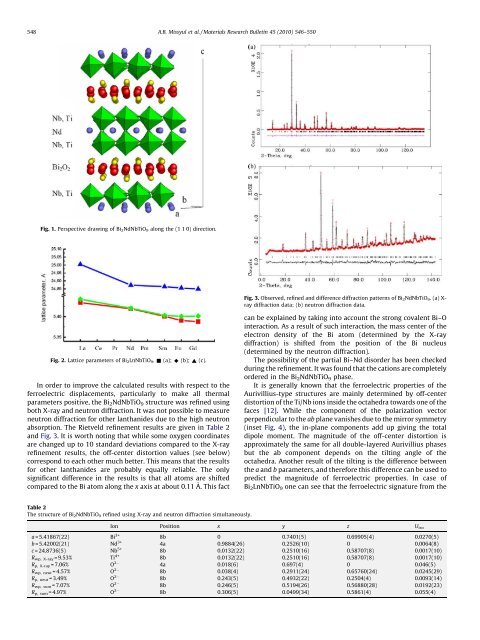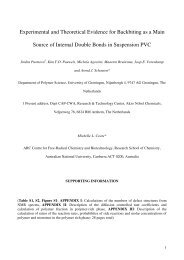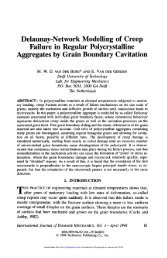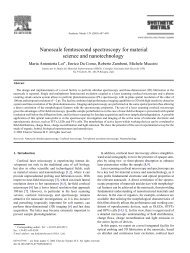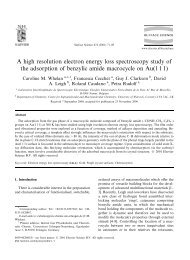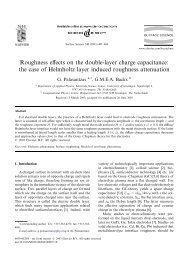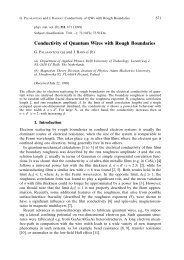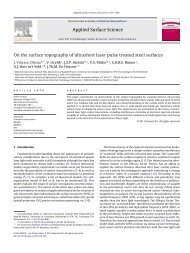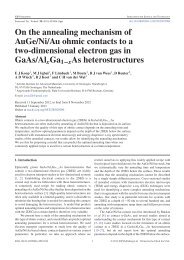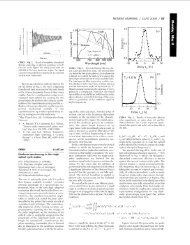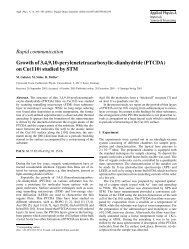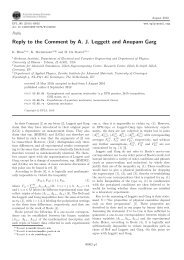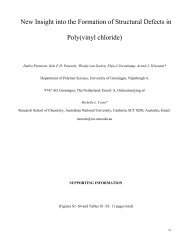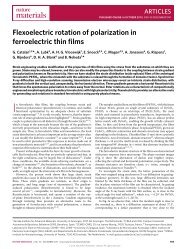Double-layered Aurivillius-type ferroelectrics with magnetic moments
Double-layered Aurivillius-type ferroelectrics with magnetic moments
Double-layered Aurivillius-type ferroelectrics with magnetic moments
Create successful ePaper yourself
Turn your PDF publications into a flip-book with our unique Google optimized e-Paper software.
548<br />
A.B. Missyul et al. / Materials Research Bulletin 45 (2010) 546–550<br />
Fig. 1. Perspective drawing of Bi 2 NdNbTiO 9 along the (1 1 0) direction.<br />
Fig. 3. Observed, refined and difference diffraction patterns of Bi 2 NdNbTiO 9 . (a) X-<br />
ray diffraction data; (b) neutron diffraction data.<br />
Fig. 2. Lattice parameters of Bi 2 LnNbTiO 9 . & (a); ^ (b); ~ (c).<br />
In order to improve the calculated results <strong>with</strong> respect to the<br />
ferroelectric displacements, particularly to make all thermal<br />
parameters positive, the Bi 2 NdNbTiO 9 structure was refined using<br />
both X-ray and neutron diffraction. It was not possible to measure<br />
neutron diffraction for other lanthanides due to the high neutron<br />
absorption. The Rietveld refinement results are given in Table 2<br />
and Fig. 3. It is worth noting that while some oxygen coordinates<br />
are changed up to 10 standard deviations compared to the X-ray<br />
refinement results, the off-center distortion values (see below)<br />
correspond to each other much better. This means that the results<br />
for other lanthanides are probably equally reliable. The only<br />
significant difference in the results is that all atoms are shifted<br />
compared to the Bi atom along the x axis at about 0.11 Å. This fact<br />
can be explained by taking into account the strong covalent Bi–O<br />
interaction. As a result of such interaction, the mass center of the<br />
electron density of the Bi atom (determined by the X-ray<br />
diffraction) is shifted from the position of the Bi nucleus<br />
(determined by the neutron diffraction).<br />
The possibility of the partial Bi–Nd disorder has been checked<br />
during the refinement. It was found that the cations are completely<br />
ordered in the Bi 2 NdNbTiO 9 phase.<br />
It is generally known that the ferroelectric properties of the<br />
<strong>Aurivillius</strong>-<strong>type</strong> structures are mainly determined by off-center<br />
distortion of the Ti/Nb ions inside the octahedra towards one of the<br />
faces [12]. While the component of the polarization vector<br />
perpendicular to the ab plane vanishes due to the mirror symmetry<br />
(inset Fig. 4), the in-plane components add up giving the total<br />
dipole moment. The magnitude of the off-center distortion is<br />
approximately the same for all double-<strong>layered</strong> <strong>Aurivillius</strong> phases<br />
but the ab component depends on the tilting angle of the<br />
octahedra. Another result of the tilting is the difference between<br />
the a and b parameters, and therefore this difference can be used to<br />
predict the magnitude of ferroelectric properties. In case of<br />
Bi 2 LnNbTiO 9 one can see that the ferroelectric signature from the<br />
Table 2<br />
The structure of Bi 2 NdNbTiO 9 refined using X-ray and neutron diffraction simultaneously.<br />
Ion Position x y z U iso<br />
a = 5.41867(22) Bi 3+ 8b 0 0.7401(5) 0.69905(4) 0.0270(5)<br />
b = 5.42002(21) Nd 3+ 4a 0.9884(26) 0.2526(10) 0 0.0064(8)<br />
c = 24.8736(5) Nb 5+ 8b 0.0132(22) 0.2510(16) 0.58707(8) 0.0017(10)<br />
R wp, X-ray = 9.53% Ti 4+ 8b 0.0132(22) 0.2510(16) 0.58707(8) 0.0017(10)<br />
R p, X-ray = 7.06% O 2 4a 0.018(6) 0.697(4) 0 0.046(5)<br />
R wp, neut = 4.57% O 2 8b 0.038(4) 0.2911(24) 0.65760(24) 0.0245(29)<br />
R p, neut = 3.49% O 2 8b 0.243(5) 0.4932(22) 0.2504(4) 0.0093(14)<br />
R wp, sum = 7.07% O 2 8b 0.246(5) 0.5194(26) 0.56880(28) 0.0192(23)<br />
R p, sum = 4.97% O 2 8b 0.306(5) 0.0499(34) 0.5861(4) 0.055(4)


